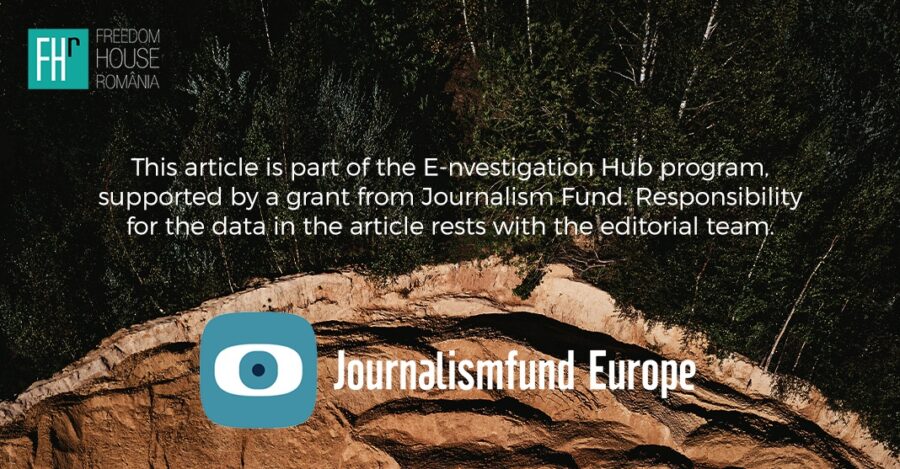Between 2021 and 2024, one-third of the tree removals in the forests of Bihor County were classified as “accidental logging,” accounting for over 300,000 cubic meters of the approximately 1 million cubic meters of trees cut.
Author: Georgiana Anghel
Natural phenomena and insect infestations are the primary causes of these removals, but bureaucracy and climate change complicate the effective management of these issues. How do these factors affect the forests, and what solutions do experts propose?
From 2021 to 2024, one-third of the tree removals recorded in the SUMAL database in Bihor County were categorized as “accidental.” In total, during this period, over 300,000 cubic meters of trees were cut under the accidental logging classification, out of more than 1 million cubic meters overall. Such removals typically occur when forests are affected by natural events, such as storms or insect infestations, or when trees that should not be cut are damaged during logging operations.
With these statistics in mind, we sought to understand the potential causes leading to such a situation, as well as the procedures in place for handling accidental logging, and whether these reasons are being misused.
In discussions with several NGOs across the country, we learned that experts can determine, after a field visit, whether reported accidental logging matches the reality outlined in SUMAL.
Dan Turiga from Agent Green, an environmental protection NGO, indicated that they have identified such discrepancies. “We found healthy, standard-quality, Class I trees marked for removal under the accidental logging category in Bistrița”, Turiga noted.
Theoretically, such cases should be easy to detect if the Forestry Guard were to inspect every declared accidental removal. However, the law only requires them to check at least 20% of the Approved Forest Management Plans (APVs) for accidental logging.
In Bihor County, in recent years, the Forestry Guard has inspected significantly more than the legally mandated minimum. According to representatives from the agency, there have been no instances of accidental logging used to justify the removal of healthy trees under false pretenses.
However, the increase in accidental logging in recent years could be partly attributed to an infestation by the European bark beetle (Ips typographus). These infestations were initially linked to a storm (a mesocyclone) in 2017, which affected areas in Bihor such as Bratca, Budureasa, Dobrești, Roșia, Finiș, Vașcău, Stâna de Vale, Padiș, Remeți, and Valea Drăganului. According to Teodor Suciu, the director of Romsilva Bihor, approximately 500,000 cubic meters of trees were downed in the mountains of Bihor during that event.
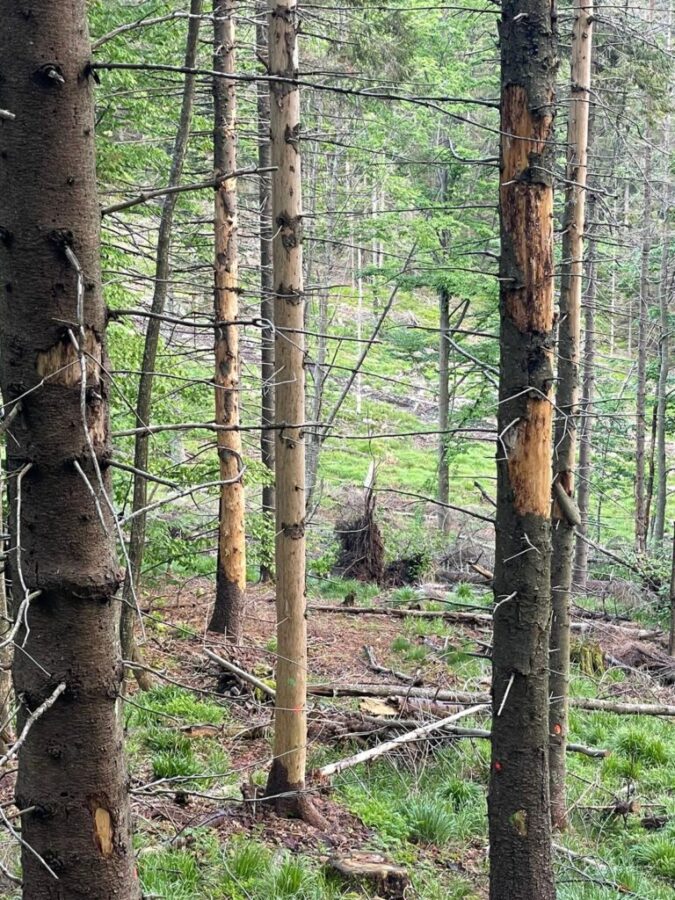
Dry trees in the forests managed by the Sfânta Maria Forest District / Photo source: Sfânta Maria Forest District
Subsequently, the downed trees in the forests attracted an infestation of bark beetles, which exclusively target spruce trees. Since then, the beetles have wreaked havoc in the forests. However, it seems that these persistent insect attacks, occurring seven years after the storm, may have another underlying cause.
Climate change and heat waves could be contributing factors, creating a favorable environment for the Ips typographus.
Ferko Jeno, the head of the Sfânta Maria Forestry District, which manages the forests of the Greek-Catholic and Roman-Catholic Churches in Bihor, states that milder winters facilitate the reproduction of these beetles. “Studies show that the beetles only die at temperatures of minus twenty degrees Celsius”, said Jeno. “We haven’t experienced such temperatures in the county for several years”. He further noted, “Due to climate change and the rising temperatures, we’ve observed that the beetles now have three flight periods per year, instead of the two they had before”. Essentially, due to the changing climate, these beetles can “gnaw” at the forest almost year-round, compared to only a few months each year in the past.
Emil Plastin, the head of the Remeți Forestry District, shares a similar sentiment. The forest they manage has lost hundreds of thousands of cubic meters compared to the approved logging plan due to the bark beetles. “We have done our part by setting up pheromone traps and barriers against these insects. Unfortunately, those managing the neighboring forests have not done their job effectively, and it has been very difficult for us to halt these Ips typographus attacks”, Plastin explained.
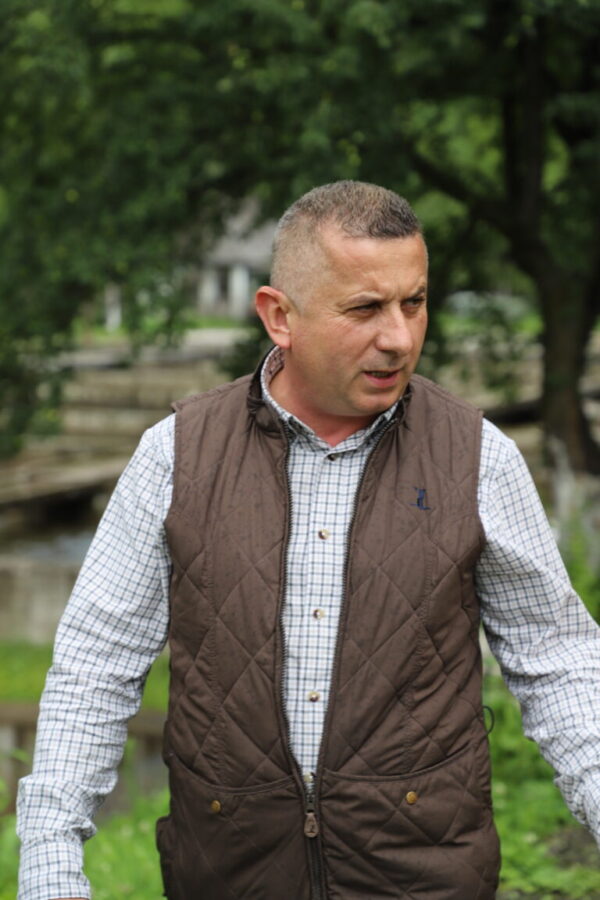
Emil Plastin, head of the Remeți Forest District, with the largest amount of accidental logging in recent years / Photo: Rahul Pange
The statements made by representatives of the forestry districts in Bihor are corroborated by other specialists, both domestic and international.
“Winters are becoming shorter and warmer, allowing the larvae of this species to survive in larger numbers. I wouldn’t call it an attack, as they are not harmful. This species is native and is taking advantage of the warming. There’s no way to stop what is to come. You simply can’t. You have to let it eat what it needs to eat and allow nature to take its course”, said Gabriel Păun, president of Agent Green. He also mentioned that our country lacks any form of national record regarding bark beetle infestations, making it impossible to estimate the damages caused specifically by these beetles.
Read also: Why some prosecutors avoid seizing trucks transporting illegal timber
In Germany, in 2020, the proportion of accidental logging accounted for three-quarters of the total volume of wood harvested, according to Stefan Kreft, an associate researcher at the Academy of Natural Forests, an independent research institute in Germany. “Spruce monocultures have rapidly degraded in many parts of Europe over the past 5-6 years”, he added.
He explained that, just as in Bihor, the infestation of this insect, which affects only spruce trees, is typically preceded by a storm. “However, storms are natural phenomena, and in a natural forest, even if dominated by spruce, bark beetle populations would not explode to the levels observed in artificial monocultures,” he stated.
The reasons these attacks are so aggressive and long-lasting, according to Stefan Kreft, include:
- Spruce, which replaces locally adapted tree species, is planted in regions (typically quite low-lying) where it is not suited, as spruce is a species specific to high mountains and northern latitudes (in Europe, Scandinavia).
- Spruce is planted in the aforementioned monocultures, providing an easy food source for bark beetles.
The German researcher specifies that trees infested by insects no longer pose a risk to healthy forests and that dead trees actually aid in forest regeneration. “The wood of a tree killed by bark beetles has reduced economic value, and its removal is costly, further diminishing profits. More importantly, the benefits of dead wood are diverse and significant: dead wood provides shade and cools the soil, thus facilitating natural regeneration,” Kreft explained.
He added that natural regeneration is preferable to planting, as it results in a more resilient new forest without costs.
“Dead wood protects regeneration from herbivorous animals, particularly deer and stags, which specialize in eating young shoots. Dead wood is important for preventing soil erosion and contributes to mitigating climate change by keeping carbon away from the atmosphere for several decades. These are just a few of the many benefits of leaving dead trees in place”, the researcher further stated.
He insists that this perspective is well-supported by scientific evidence and is increasingly accepted by informed forest managers.
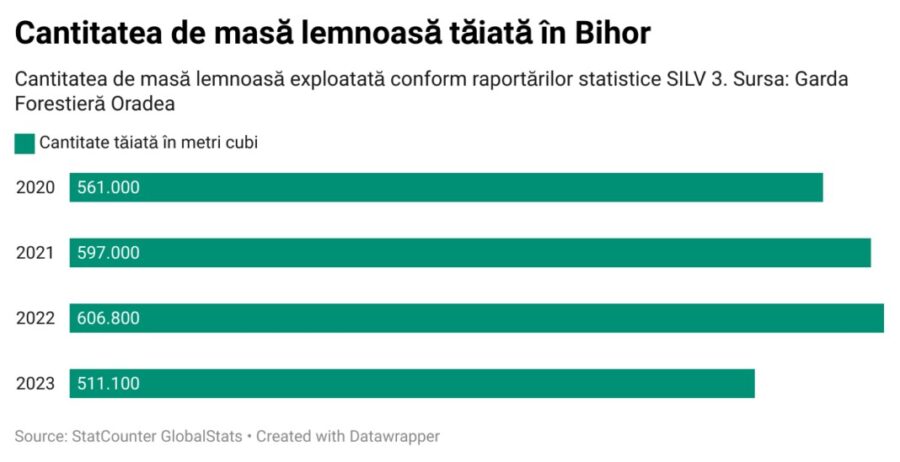
Created with Datawrapper
This theory is supported by another activist. “The old tradition of forestry viewed ‘sanitary logging’ as an important way to control certain outbreaks of tree pathogens. However, in the context of climate change, there is increasingly less evidence that these interventions have a positive impact on surrounding ecosystems; on the contrary, in many cases, the effect seems to be negative,” says Siim Kureso, European Forest Campaigner at Fern, an NGO advocating for forest conservation in Belgium, France, and Germany.
However, Kureso explains, there are growing reasons for intervention, as pathogens spread more easily among trees subjected to climate stress. “Sometimes, the increase in ‘sanitary logging’ is motivated by this old understanding of doing what is right, while at other times, the rules surrounding this practice are exploited as a loophole to bypass forest management restrictions simply to harvest timber,” the quoted source added.
A forestry engineer from Bihor also stated that the best solution in such cases of infestation is to allow nature to take its course. This would be a wiser decision, he explained, considering that the trees that would grow are likely to be better adapted to the current conditions and much more resilient. However, in light of the fact that forests across Europe have been devastated by this beetle in recent years, he does not believe that European governments would dare to make such an unpopular decision.
In the current conditions, where most European countries continue to remove trees from forests, and in the existing climate context where these infestations could persist and become increasingly difficult to manage, Romania should change its approach to managing accidental logging.
Ferko Jeno, the head of the Sfânta Maria Forestry District, explained that in Germany, as well as in Poland, for example, forest managers can remove timber from the forest immediately in cases of insect infestations or storm damage.
In Romania, however, bureaucracy slows down the removal of attacked or downed trees by weeks. After a natural phenomenon, the forest ranger is required to prepare a report within five days. Following this, the report enters the decision-making circuit, and the head of the forestry district is obliged to prioritize the issuance of a delegation for marking the affected trees. In the field, the ranger, along with a representative from the district, marks the downed or affected trees with a marking hammer. They collect data from the field, mark each tree, measure the diameter, determine the quality class, and measure the length of the trees. The species, diameter, length, and quality class must be recorded in SUMAL, which results in the APV (Approval for Logging).
This APV is subject to notification to the Forest Guard, in which the district informs them whether they have any accidental products, and the guard can decide whether or not to conduct an inspection. According to the law, the guard has 15 days to decide whether to carry out the inspection. Only after the Forest Guard decides whether to inspect can the forestry district begin procedures for valorizing the timber.
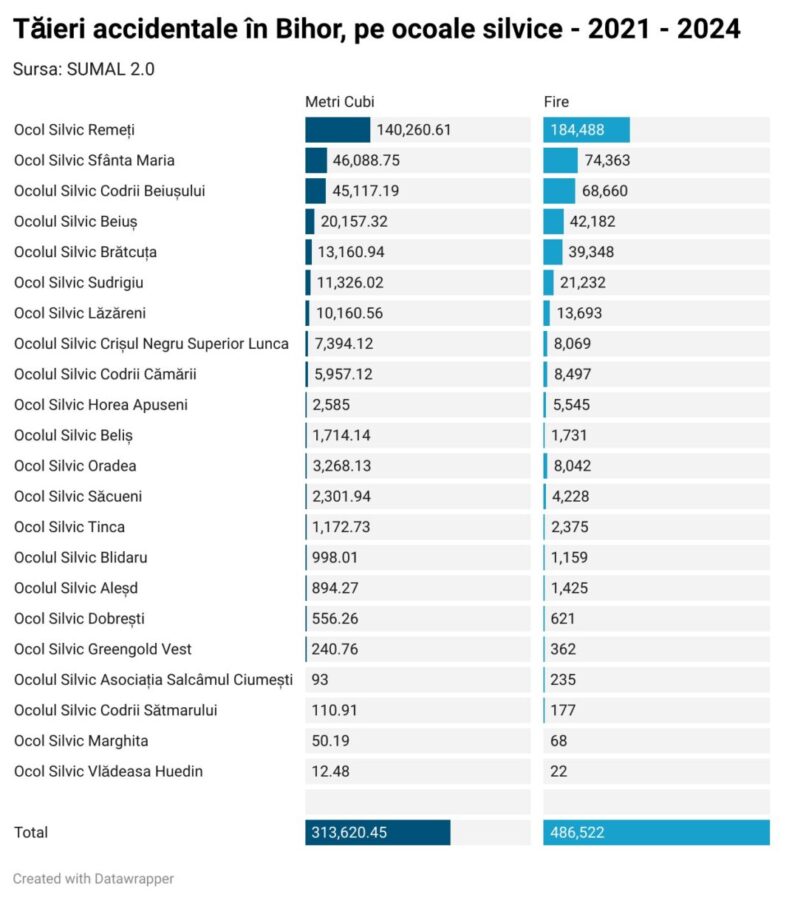
Created with Datawrapper
According to information provided by the Forest Guard in Oradea, there are still downed trees in the forests of Bihor from the storm in 2017, as well as trees affected by bark beetles, “in the quasi-virgin forests within the Remeți Forestry District and in specially protected areas in the Apuseni Natural Park, across the forestry districts of Codrii Beiușului, Lăzăreni, Beliș, Sudrigiu, and Horea Apuseni, where the extraction of affected trees is prohibited, with an approximate volume of 250,000 cubic meters”.
Between 2001 and 2023, Bihor County lost 15,700 hectares of forest cover, equivalent to a 6.4% decrease in forest cover since 2000.
In 2010, Bihor County had 222,000 hectares of natural forest, which spanned 31% of its area. By 2023, the county had lost 1,060 hectares of natural forest.
Follow PressHub also on Google News!
